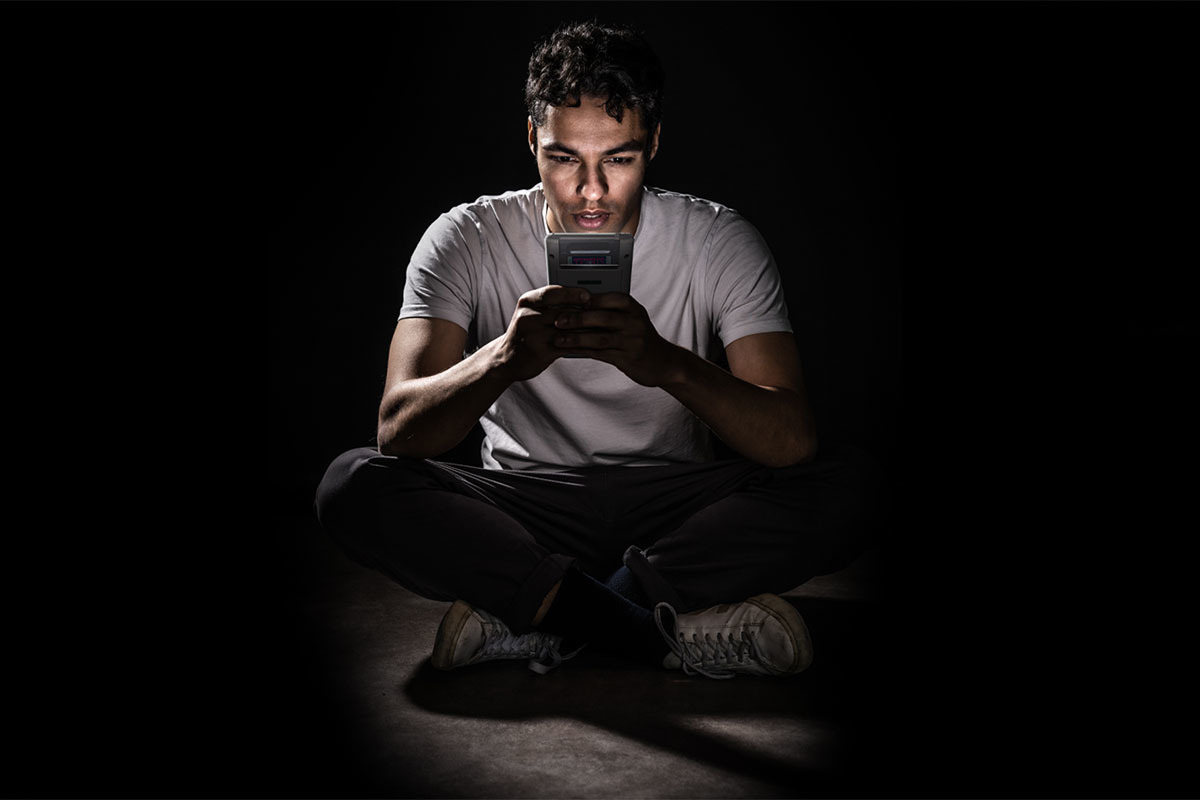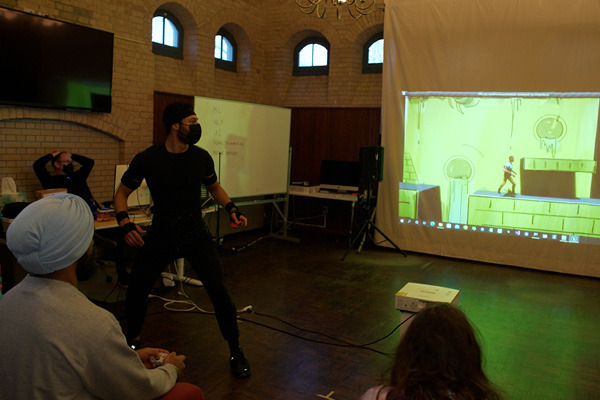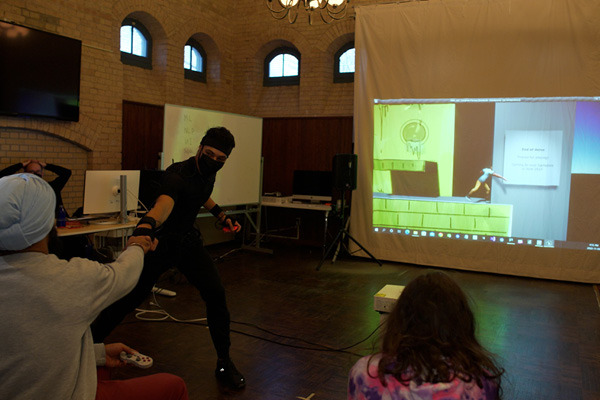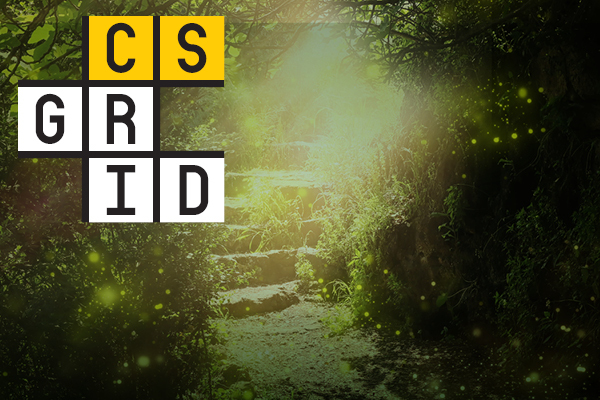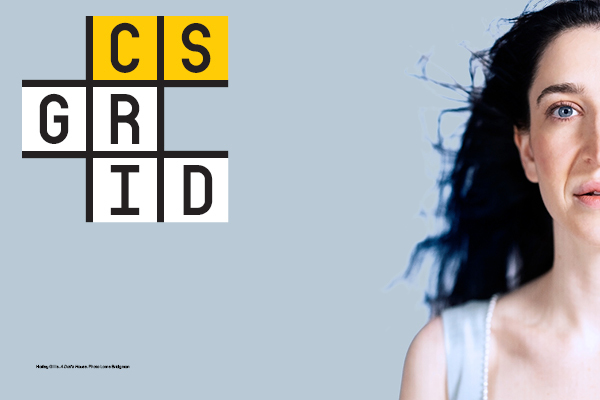Canadian Stage interviews Sébastien Heins and David Rokeby
It's one thing to dream, another to practice. – Sébastien Heins
No Save Points sounds like a work of fiction. Using state-of-the-art motion capture and haptic technology, the audience plays an active role by controlling the performance on stage, transporting spectators to the imaginary video game world created and performed by theatre veteran Sébastien Heins. An Outside the March production, the piece is inspired by the real-life story of Hein's mother being diagnosed with Huntington's Disease, a rare genetic illness and exploration into the euphoric relationship with video games as a way of escape when dealing with this brutal reality.
Sébastien Heins was one of the BMO Lab's first artists in residence in 2020-21, a partnership between the BMO Lab and Canadian Stage, in which two artists were selected to immerse themselves in the lab's technologies and experiment with ways to apply them to live performance.
In advance of the premiere of No Save Points, “a play you can play,” in this edition of CS Grid, we catch up with artist Sébastien Heins and his mentor David Rokeby, BMO Lab Associate Director. We’re fascinated to learn more about the inner artistic workings behind this innovative new theatre production and how the Canadian Stage residency allowed Sébastien to expand on his artistic endeavours.
Congratulations on No Save Points! How did the Canadian Stage residency impact the production and your trajectory as an artist?
Sébastien Heins: Before the Canadian Stage residency, I pondered, “What would it take to make a live-action videogame?” but my skillset was too limited. I wasn't thinking digital; I wasn't thinking motion capture suit (aka. mo-cap). Instead, I was thinking of in-ear monitors and web-based applications. Before Canadian Stage, I had spent maybe 45 minutes in a mocap suit. Now, I’ve clocked 50 to 100 hours working in a mo-cap suit to date. Even though I still have a lot to learn, it’s become an extension of my artistry, and my discoveries can be seen in No Save Points.
The residency was an invaluable learning process as an artist. I got to test out switching from one avatar to the next, how to make a character fly or swim, how to create emotion with a faceless character, and how to have fun while doing that.
I first had to be familiar with the capabilities of a mo-cap while experimenting at the lab to spark opportunities in considering how the audience could influence the motion capture experience. So one night, David hooked me up to a little green man character in a forest. David and I worked out a choreography and dummied up a controller which would, in theory, be connected to my body. Controller buttons were pressed while I performed the selected actions in the game world (standing, walking, jumping, turning, sitting), which led to one of the concepts behind No Save Points.
The residency was an invaluable learning process as an artist. – Sébastien Heins
As an artist, what's the significance of receiving 1:1 mentorship support from David Rokeby?
SH: I came from a theatre background where mentorship and guidance were baked into my experience. As a child, Richard McMillan showed me what professionalism, poise, and mischief looked like in The Lion King. At National Theatre School, visiting artists like David Latham, Ker Wells, and Jennifer Tarver instructed me on how to create, serve the story, and be imaginative. Martha Henry was my favourite person to talk to, between scenes, in Stratford, and my favourite emails were always from her. She always had time to give advice.
David has 40+ years of hands-on experience in live interactive art, encompassing all the teachings from the thought leaders mentioned above. He has a strong drive to express the depths of humanity using this medium and understands why art and technology have always been inseparable. David is also filled with generosity and wit, and I appreciate the hundreds of questions he asks to get me thinking.
What is your mentorship process working with Sébastien Heins?
David Rokeby: It is not a mentorship process. It is a symbiotic process! Sébastien is a great experimenter. He is remarkably creatively open to exploring and trying things out. Since I’m always creating new and unusual systems and possibilities, we make a very good team. Sébastien quickly finds new opportunities to use these strange new things, and this is extremely generative. He helps me see how to expand these things we create in the lab into handy and provocative additions to the theatrical palette. Then he brings a strong and focused discipline to bringing these explorations into production situations.
It is a symbiotic process! Sébastien is a great experimenter. He is remarkably creatively open to exploring and trying things out. – David Rokeby
What’s the difference in the use of motion capture demonstrated in Arturo Ui compared to No Save Points?
SH: In The Resistible Rise of Arturo Ui, we created a digital avatar of me, stitched together using many photographs. I then got on stage in a mo-cap suit and piloted that avatar while performing dance and movement. At one point, I synchronized my marching in step with 20 copies of me, like a marching army of Sébastiens. We also played with the concept of "Whitewashing" and had the avatars of me transition from real to white throughout the song.
In No Save Points, the audience sees a 15-foot-tall Gameboy screen while playing a side-scrolling video game. The little boy that participating artists are piloting in that videogame was conceptualized by Alex Lyons, our illustrator, and 3D-modelled by Youil Samara, our modeller. When the audience plays the game, the little boy jumps over fires, pulls boxes, and goes swimming, but instead of all of his actions being canned, they're performed live, by me, in the motion capture suit. Similarly to Marshmallow Laser Feast's Dream, I'm live-animating a digital character, but here, I have to integrate the live inputs made by the audience members playing the game.
...we can think of technologies as avatars of our human desires: robots as a reflection of our fear of the fragility and ephemerality of our mortal bodies, computers as attempts to step beyond the limitations that we might imagine our subjective viewpoints force upon us. – David Rokeby
What's the role of technology in art?
DR: There are so many ways to respond to this question!
Originally the terms ‘art’ and ’technology’ had effectively the same meaning: “The first part of the word, techn actually did mean “art” or “craft” from Greek, while the second half logy means more literally “the writings on” or “the accumulated knowledge about.” - OUPblog, Oxford University Press
Artists have always used technology (grinding their own pigments for paint, for example). The piano was one of the most complex technologies of its time. Theatre has always involved a variety of technologies to support the storytelling.
Since technologies have so much impact on contemporary life, technology and its effect on our culture is naturally a prime area for creative artists to probe, plumb, explore, question and critique.
If we think about what technologies are: the fruits of passionately held human desires (to control, to tame, to understand, to refine, to make, to measure, to be omniscient, to be omnipresent, to be immortal), then we can think of technologies as avatars of our human desires: robots as a reflection of our fear of the fragility and ephemerality of our mortal bodies, computers as attempts to step beyond the limitations that we might imagine our subjective viewpoints force upon us. As such, technology serves as a foil for our human selves, each revealing, in relief and contrast, truths and fallacies about the other that can illuminate our human condition in unusual, unexpected, yet deeply relevant ways.
Motion capture is not only a fascinating way to control a video game character with your body but is also an invaluable way to create richer relationships between our bodies and technologies. – David Rokeby
What's so special about motion capture?
DR: To start, motion capture is simply very cool. But that is not what is special about it. Most of our engagements with technologies in our lives do NOT engage with our physical bodies. But our physical bodies and our sense of moving through the world in our bodies are fundamental to our human experience. Motion capture is not only a fascinating way to control a video game character with your body but is also an invaluable way to create richer relationships between our bodies and technologies.
Motion capture allows us to engage with technologies in ways that allow our embodied senses to be active, creative, and critical, not just our eyes, our ears, and our brain, and if the future continues to be fulfilling with ever new layers of technological engagement, then I think finding ways to create meaningful physical engagements is necessary.
No Save Points tickets are now available.
On stage June 6 – 25, 2023, at the Lighthouse ArtSpace.
Buy Tickets

